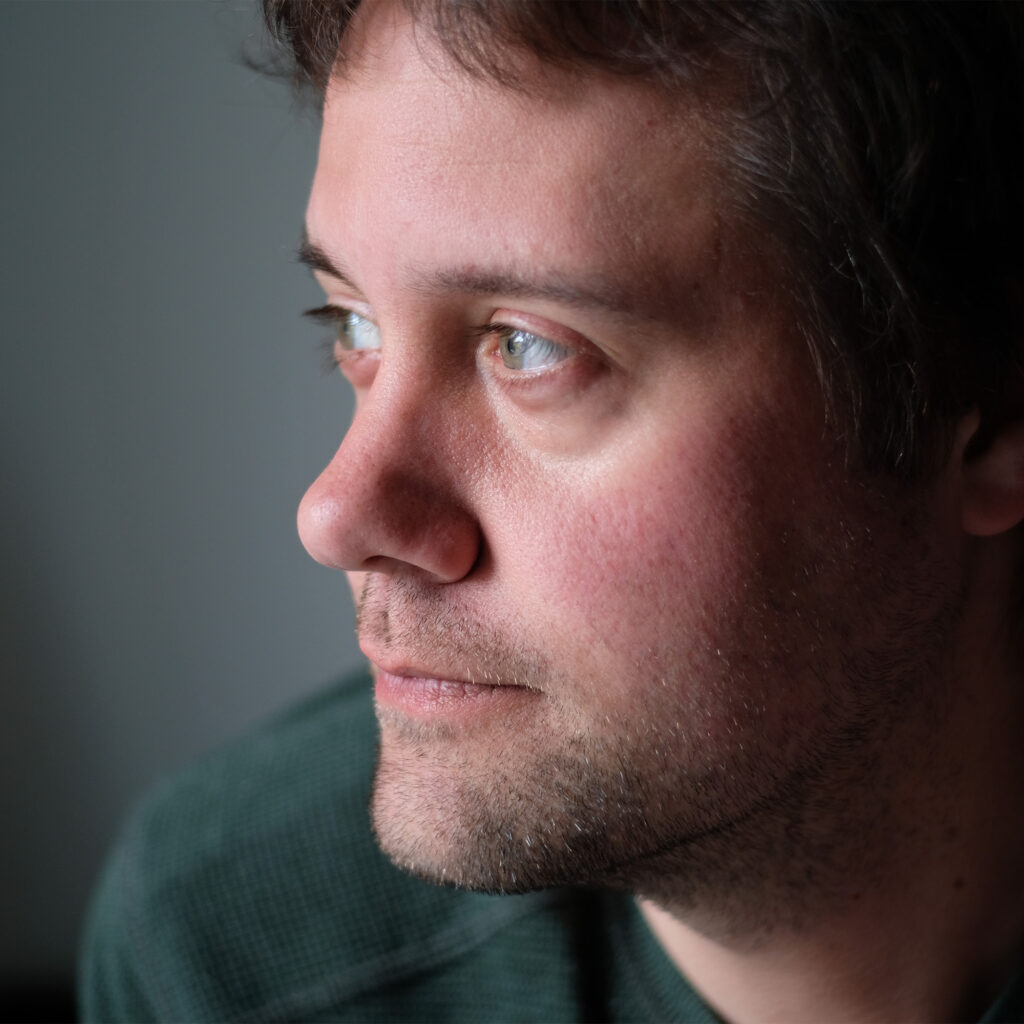Month: April 2023
Book Review: A knife so sharp its edge cannot be seen by Erin Noteboom
It’s been a while since Erin Noteboom’s last book of poetry, eighteen years in fact. It’s not as if she and the muse of poetry were not on speaking terms as in the interim her poems have appeared in the anthologies Best Canadian Poetry (2018, 2020) and journals like Fiddlehead, Grain, The Malahat Review and, quite happily, TNQ. Then, of course, there are the four award- winning fantasy novels for young adult readers, written under the name of Erin Bow. Did I mention her memoir (The Mongoose Diaries, 2007). Last and the polar opposite of least, Noteboom admits in her “Acknowledgements” that this collection has been an on-and-off project for more than a decade. A knife so sharp its edge cannot be seen, one of Brick Book’s spring releases, rewards anticipation.
The collection is the first in which Noteboom’s two most consistent areas of professional and artistic interest intersect: science and poetry. Apart from the many other motivations that a poet is heir to, the book is the result of her revelation “that science is not off-limits as a subject of poetry,” to use her own words. This poems are well informed and well illumined by science, especially in the section entitled “skiagraphs,” an early term for X-rays. The poems here explore scientists’ first investigations into radiation and its gruesome and lasting effects, especially the painstaking efforts of the Curies to extract radium: “Forty tons of corrosive chemicals/Four hundred tons of water/pinprick by pinprick,/radium chloride—point one of a gram at last aglow/like jam on the windowsill.” Perhaps the most sadly beautiful poem in this section is “Radium Girls,” the story of the many female factory workers from 1917 to the early 1920s who became sick and died of radiation poisoning after they were told that the radium powder that they were using to paint self-illuminating clock dials was harmless, so much so that they could sharpen their brush ends by twisting them on their lips. The poem ends in heart-breaking fashion by focusing on three sisters, one whose hips break, another who loses both her teeth and her children, and a third who dies but is “lifted from her grave. Her skull made powder./Her long bones sliced to two-inch buttons…her dazzling bones can still expose an X-ray.” Poems about American atomic bomb testing round out this section, all of which remind me of what Noteboom says in “Quarks: An Exegesis” when she refers to “a model of nuclear physics that has so recently, troublingly and triumphantly been put to real use.”
Though allusions to science and scientists also appear throughout the collection, Noteboom writes about many other things in a variety of styles. Yet she calls this her “book of equations,” based on her sense that a metaphor is an equation because, in a sense, they both say “this is that.” To illustrate her point she’s uses a poetic equation from one of the poems in the section “too strong to stop, too sweet to lose,” a long poem published originally in TNQ: “the wind in green wheat = a scythe being sharpened.” The poem is actually a series of questions and answers, such as
What do we hope for?
For hope itself, for honey
at the bottom of bitter tea.
Though hope keeps pulling loads
that would break the hearts of horses.
In lifeboats we strain our eyes
for a white curl that might be either sail
or wave
Other equally remarkable poems in the collection are the eight ghazals, each beginning with lines from other poets, ranging from Lorna Crozier to Pablo Neruda; those in the section “poems with a movement toward the particular, one of which, “things that the dead have touched,” asks, “What shall we do with their socks, for instance,” with the fact that their “fingerprints evaporate…the voice demagnetizes/on the answer tape, the smell of skin/ lifts free of sweaters”; and the long poem that emphatically ends the collection, “how to write at the end of the world,” written for and performed on the stage for Home Truths, an International Women’s Day event, which advises, “Write the things you love.”
“To write the things you love” is a suitable way to describe this consistently strong collection. Clearly, Noteboom has heeded her own advice but I’d go further, borrowing a verb that she once used to describe her difficulty in trying to write a series of rune poems, by which she has been “enspelled.” As she is enspelled, so are we.
Photo by Zoran Borojevic on Unsplash
Read more
Finding the Form with Jamaluddin Aram
I grab coffee with a writer friend whenever she is in town. The conversation is always about writing; that it is hard, that finding an agent is hard, that a book contract would be great. Then we envy authors whose agents brag about them and their six-figure deals, authors who attend galas and go on book tours to cities like Paris, Venice, New York. We sip our coffee that has gone cold and return to the bitter reality that our own writing lacks depth, madness, wisdom, ease.
I remember one time we jokingly decided to try to write a bad story. The worst we could do.
Thus this story.
I knew that the reader is a very light sleeper, and that the narrative is a dream. I also knew that experimentation with form disturbs the sleeper as much as sloppy application of words, clunky sentence structures, and the author’s disinterest in the fate of his characters. But I didn’t care. I sent the literary critic in me on a much needed break, and set out to do whatever my heart wanted.
My heart wants pleasure when it comes to literature, specially writing it. The joy is in solving problems. My native tongue is Farsi. So every day I come face to face with the English language. That is always a brilliant start. This time, however, I needed a bigger challenge. I tried to write a story, an exercise—attempting fiction within fiction—where I had to move between different
temporal and spatial spheres without breaking continuity. (After all I care about the sleeper and his dream.)
Years ago I had read “The Circular Ruin” by Borges. The story, at the risk of oversimplifying it, is about a man who dreams a young man to ‘impose him on reality’. Once the young man is born, the man erases his memory and sends him on a similar journey that he himself had to take to arrive at the beginning of the story. After some time, he receives news that in a temple of the North there is a charmed man who can walk on fire. The man immediately recognizes him as the young man born out of his dream. Decades later when the man knows death is upon him and he walks through sheets of flame and the fire does not burn his flesh, he understands ‘that he also was an illusion, that someone else was dreaming him.’
Borges first encountered infinity as a child looking at a Japanese scene printed on a large biscuit tin. At a corner of the image he saw the same biscuit tin reappear with the same picture, and in it the same picture again.
My story is not quite the Japanese scene on Borges’s biscuit tin but it works with similar ideas. A novelist is writing a novel whose protagonist is a short story writer. Although we learn about the novelist (who is a character) in the short story writer’s work, we know that the novelist created the short story writer. We also know that the novelist is not the ultimate creator, he himself was created by another person and that person by another. Who then is the ultimate writer of this story? The short story writer? The novelist? The person who created the novelist? The person who created the person who created the novelist? And that question can be repeated on and on until someone asks that inevitable question, “Well, didn’t you write it?” To which I would respond, “Yes, I did.” And I firmly believe in destiny.

Jamaluddin Aram is a writer from Kabul, Afghanistan. His works have appeared in Numero Cinq, Cagibi, and The Globe and Mail among others. Aram’s short story “This Hard Easy Life” was a finalist for RBC Bronwen Wallace Award for Emerging Writers in 2020. His debut novel, Nothing Good Happens in Wazirabad on Wednesday, is forthcoming from Scribner Canada in June 2023. Aram has a bachelor’s degree in English and history from Union College in Schenectady, New York. He lives in Toronto.
Photo by Mithea and Prophsee Journals on Unsplash
Michelle Barker’s Writing Space
I’m fortunate to have a second bedroom in my apartment that I recently turned into an office space. I write in many different genres, but I’m a novelist at heart. For years, I dreamed of having a wall that looked like Michael Scofield’s wall in the TV series Prison Break—covered in sticky notes and photographs and relevant articles and maps. I always thought Scofield’s wall
looked so professional. So intense. How could a wall like that not produce a great novel?
As soon as I had my office space, I taped index cards to the wall—a scene-by-scene breakdown of my work in progress. I put up a timeline and photographs, maps, and a calendar from the year I was writing about. It looked fabulous. But within about a month, it all came down. My Prison Break wall was not providing the inspiration I had hoped. Instead, it had turned into busy work that I finally had to admit was nothing more than a form of procrastination.
I come to my office early in the morning (long before sunrise, these days), every morning without fail, and face…a blank wall. With a coffee at my side, I open my laptop and get to work. The blank wall is a fairer reflection of my process. The space serves the work. No nonsense, is what it says to me. No distractions. Put your head down and get the job done.
Usually, my desk is a mess of papers, but everything I need is at hand, including the notebook where I scribble down ideas whenever they pop into my head. My phone is set to silent. On the far wall above my piano is an artist’s rendition of the storefront of Shakespeare and Co., a wonderful bookstore in Paris. Closer is my bike, set up on the trainer for when I need a break from working. Closer still, a photograph of my youngest child who passed away. He watches me work with an impish grin on his face that always makes me smile. Traffic passes outside my window, a barometer of my level of concentration. When I can barely hear it, I know the work is going well.

Michelle Barker is the author of the award-winning novels, The House of One Thousand Eyes and My Long List of Impossible Things. She works as a senior editor at The Darling Axe. www.michellebarker.ca
What is John Vardon Reading?
When it comes to the reading of new books, and and I’m happy to say that the opportunity comes for me much more frequently in retirement, my choice ( mostly literary) is governed by the love of specific authors, curiosity aroused by reading and conversations with friends, a certain degree of serendipity, or a combination of the above. In my house overflowing with books, I sometimes choose titles at random or find an earlier book from an author I have just read and enjoyed. I do the same in browsing thrift shops and stores selling books used or new.
A less familiar reason for my reading choices is faith in the publisher. I have bought books from Gaspereau Press simply because I like their unique design. Fortunately, they also publish some superlative writers. For quality of writing, content, and design, however, I don’t think Biblioasis has an equal in Canada ( except perhaps The Porcupine’s Quill), thanks in part to editors like John Metcalf and publisher-editor Dan Wells. As soon as I recognize their Cervantes-suggestive windmill logo on the spine, I pull the book of the shelf, regardless of genre. And so it
is that I read poet Robyn Sarah’s memoir about relearning to play the piano, Music Late and Soon, Marius Kociejowski’s A Factotum in the Book Trade, an account of the author’s long experience in selling antiquarian books, and Emily Urquhart’s book of essays, including “Years Thought Days,” a sadly beautiful reflection on her father Tony’s descent into dementia.
I have digressed a long-winded way from what I am reading now. So let me just mention Lisa Moore, a fine fiction writer who has won The Canadian Authors Association Short Fiction Prize, The Commonwealth Book Prize, and CBC’s Canada Reads. Nominated, long-listed, or short-listed for other prizes, including the Mann-Booker Prize, Moore first published in TNQ almost three decades ago. She also figured prominently in issue 91, which featured fiction from Newfoundland’s Burning Rock Group.
I have just finished Something for Everyone, her latest and possibly best story collection (Anansi, 2018), published 16 years after her first, the time in between devoted to writing one other story collection and five novels.
Few writers can combine plot, characters and narrative technique as engagingly and intelligently as Moore. For me , it’s the third of these elements, the way she tells stories, that elevates her writing so far above the ordinary. The ten stories in Something for Everyone demonstrate her narrative skills convincingly and consistently. Her narrative point of view has always been adventurous and varied, her command of voice consistent, and her use of language, especially her orchestration of detail, impeccable. Just consider these randomly selected lines from “The Fjord of Eternity: “The light at that hour was Bubblicious pink and Orange Crush orange and hazard-tape yellow and it shone through the haze rising from the water, brackish and old-fridge
smelling.”
Her narrative viewpoint is both varied and versatile, too much so to explain adequately in anything short of a PHD thesis. Take for example her tactic of focusing on one incident in a story, moving back and forth from it in time, as she does in “Lovers with the Intensity I’m Talking About”, in which two ex-lovers meet and talk awkwardly in the entrance to a large grocery store,
the automatic doors opening and closing, shoppers entering and entering as a storm rages outside, a central incident reflecting the way in which characters come and go in the narrator’s recollected tempestuous life.
A cliche in the book promotion business is to say that you wouldn’t hesitate to recommend a work to anyone capable of reading. But I do hesitate, bearing in mind the advice of Martin Latham, author of A Bookseller’s Tale: “If you want to get someone to enjoy your heartfelt recommendation, a sort of take/it-or-leave-it insouciance is required. An overly enthusiastic recommendation gives your friend a burden: he or she must find the book life -changing, or they are not deep enough, or insufficiently caring about the friendship itself.” I’m not sure how I’d feel about anyone who disliked Lisa Moore, but I am sure that I don’t wan’t to find out. That said, I did give my eldest daughter a copy of Moore’s selected stories, knowing that she would, as a fiction writer herself, appreciate them more than others.
I am now ninety pages into Moore’s latest novel, this is how we love, drawn in irresistibly by the the was first paragraph, which begins with the narrator learning in a late-night phone call of her son’s near fatal stabbing. Moore’s fictional universe unfolding as it should.

After conducting the interview and writing these three blog posts, John Vardon is now participating as a judge for this year’s Nick Blatchford Occasional Verse Contest.
Photo by Aida Geraeva on Unsplash
What is Matthew Hollett Reading?
I first encountered the work of Irish writer and artist Sara Baume through a friend who recommended her novel A Line Made By Walking. The title immediately intrigued me – it’s plucked from an artwork by British artist Richard Long, who in 1967 walked back and forth across a field until his path was well-trod enough to became a visible line. I remember marveling over Long’s walk-work when I was studying conceptual art and photography in art school. Documented in a muted black and white photograph, the artist’s path stretches towards a cluster of trees and back, plain and shining. Nothing could be simpler, yet it felt like an invitation to ask questions about art that I had never considered before.
So I read Sara Baume’s curiously titled A Line Made By Walking, and I loved it. For me, Baume’s novel captures something of the post-MFA doldrums – after years of focused, intense work among fellow creatives and colleagues, being plunked into a world that doesn’t know or care about conceptual photography, psychogeography, or the Oulipo leaves you a little adrift and broken-hearted. In A Line Made By Walking, Frankie is a troubled artist who leaves Dublin in search of solace and space, moving into an ancient cottage once inhabited by her late grandmother. She walks, sulks, and photographs small dead animals, attempting to pull herself together as the house falls apart around her. It’s a novel about depression and grief, about looking closely at things that make you uncomfortable, and about seeking comfort in a dispassionate world. It’s also rooted in place in a way that I really love. Baume’s prose is restless and evocative, with the concise inquisitiveness of the best poetry.
Though she’s published four books, in interviews Sara Baume calls herself an artist first. Much of her writing is semiautobiographical. Her tiny painted plaster sculptures of birds are scattered throughout Handiwork, a 2020 nonfiction project that perhaps comes closest to synthesizing her art and writing practices. “I have always felt caught between two languages, though I can only speak in one. The one I can speak goes down on paper and into my laptop, in the hours before noon. The one I cannot speak goes down in small painted objects, in the hours after.”
Handiwork is a book you can dart, birdlike, in and out of. It’s not quite a journal, but an interwoven series of memories, musings, and impressions. Baume writes about the soundscape of her studio, the poetics of migrating birds, the paint under her fingernails, and her relationship with her late father, “a scratch-builder of the monumental” who built everything by hand. His memory lends the book a certain melancholy, though Baume’s observations are mostly buoyant, wry and lyrical. “I would like to know at what stage of life a person stops making small, painted objects, and how I managed to overshoot it.” As an artist-turned-writer myself, Handiwork’s everyday reckonings hit home. It’s rare to come across a book that captures not only the artmaking process, but the artmaking instinct – along with the second-guessing, callouses, and occasional moments of magic that accompany that way of being.

Matthew Hollett is a writer and photographer in St. John’s, Newfoundland (Ktaqmkuk). His work explores landscape and memory through photography, writing and walking. Optic Nerve, a collection of poems about photography and visual perception, has just been published by Brick Books. Album Rock (2018) is a work of creative nonfiction and poetry investigating a curious photograph taken in Newfoundland in the 1850s. Matthew won the 2020 CBC Poetry Prize, and has previously been awarded the NLCU Fresh Fish Award for Emerging Writers, The Fiddlehead’s Ralph Gustafson Prize for Best Poem, and VANL-CARFAC’s Critical Eye Award for art writing.
Photo by Dariusz Sankowski on Unsplash



